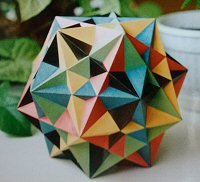Little Adventures
*
I Discover Polyhedra
 In the early 1970s, I was back from Vietnam and searching for my place in the world.
Things which had seemed so certain before the war were no longer so. I returned to
Penn State as a graduate student to sort things out and to get an advanced degree
at Uncle Sam's expense. Mostly I worked hard, but there came those times when I was
ready for something completely different.
In the early 1970s, I was back from Vietnam and searching for my place in the world.
Things which had seemed so certain before the war were no longer so. I returned to
Penn State as a graduate student to sort things out and to get an advanced degree
at Uncle Sam's expense. Mostly I worked hard, but there came those times when I was
ready for something completely different.
One day when I was poking around at the local hippy news stand, I found a strange counter-culture newspaper called The Dome Cookbook. Here the authors explained why it was better to live in a geodesic dome than in a traditional house. Pictures of dome communities out west were accompanied by articles critical of local building codes which preferred structures with vertical walls. When I came to the step-by-step instructions for building a dome house, I laughed out loud and bought the paper. Back at my apartment I read how it was done. A dome house is shaped roughly like half of a very large ping-pong ball. The framework of the structure is made from wooden triangles. The article said that this framework was very similar to half of an icosahedron. Once you have the framework, you go to a junk yard and cut the roofs off of a dozen cars. These are then used to cover the wooden skeleton of the dome.
I was amused and intrigued… what a strange idea. I decided to build a little cardboard model of a dome house just to see what it would look like. To do this I needed to find out something about icosahedra, so I went to the campus library in search of information on the subject. What I found there was knowledge, truth and an enduring pastime.
What I found that day, tucked away in its proper place in a low ceilinged, dusty and dimly lit room filled with obscure texts on mathematics, was a book called Mathematical Models. Sure enough, here was information on how to build an icosahedron, but that only took a single page. Why limit myself to a dome when here were instructions for creating dozens of polyhedron models… everything from the tetrahedron and the cube to the wondrous great rhombic triacontahedron. I was fascinated by the perfect 3D symmetry of all these models, as well as by their tongue-twisting names, and I just had to make some of them… I ended up making more than twenty.
Drawing the patterns of pieces on computer cards and using white glue and scotch tape, I assembled my first model, a great icosahedron. This was truly great! The assembly process was fascinating, and the truth inherent in the models was comforting at that turbulent time in my life… imagine an alien being named Klang who lives on a planet in a far away part of the universe. Klang teaches mathematics at a small education dome. The dome is made out of two-by-fours and car tops. Klang is certain to know about the same exact polyhedra that I do. For over two thousand years men have known of the basic polyhedra, and these will not change in another ten thousand years. To know about polyhedra is to know one thing, at least, that is true for ever and for always. I like that.
I built cubes and dodecahedra, icosahedra and snub cubes. My master work was the five cubes model shown above. I built models out of cardboard, models out of wood and models out of glass. I still build them occasionally even after 20 years, and it is always the same. Drawing the parts and cutting them out is tedious, but assembling the finished model is an interesting adventure in craftsmanship. I longed for a computer program to print the parts for me, but back then all I had access to were slow typewriter-like terminals connected to a ponderous IBM mainframe. My little "parts printing" program would just have to wait. And wait and wait.